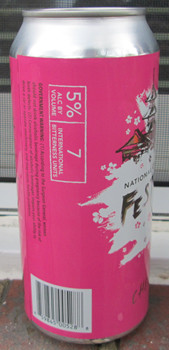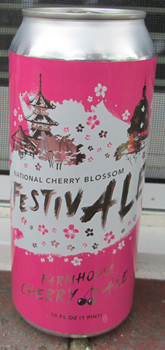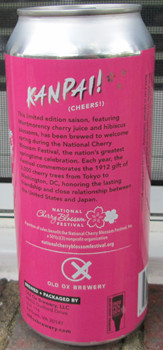Old Ox: FestivAle
 |
 |
 |
It's spring in DC and that means Cherry Blossoms! This can from Old Ox in Ashburn, Virginia came out in 2018 as part of the National Cherry Blossom Festival. I love the design, and like the local history tie-in. (It's was reissued in 2019).
The Cherry Blossom Festival dates back to the 1910s. The idea of planting cherry trees in DC dates back to the 1880s. In 1909 the Japanese Embassy learned of plans to plant the trees along the Tidal Basin and they asked if they could donate over 2,000 of them. The (William Howard) Taft administration (1909-1912) agreed. Unfortunately the original shipment in 1910 had to be burned when it was discovered the trees were infested with agricultural pests. A new shipment (presumably inspected more carefully!) was sent for 1912.
In a ceremony on March 27, 1912, First Lady Helen Taft and Viscountess Chinda, wife of the Japanese ambassador, planted the first two of these trees on the north bank of the Tidal Basin in West Potomac Park. At the end of the ceremony, the First Lady presented Viscountess Chinda with a bouquet of 'American Beauty' roses. These two trees still stand at the terminus of 17th Street Southwest, marked by a large plaque. By 1915, the United States government had responded with a gift of flowering dogwood trees to the people of Japan.
From 1913 to 1920, trees of the Somei-Yoshino variety, which comprised 1800 of the gift, were planted around the Tidal Basin. Trees of 11 other cultivars, and the remaining Yoshinos, were planted in East Potomac Park.
The first "Cherry Blossom Festival" was held in late 1934 under joint sponsorship by numerous civic groups, becoming an annual event. The cherry trees had by this point become an established part of the nation's capital. In 1938, plans to cut down trees to clear ground for the Jefferson Memorial prompted a group of women to chain themselves together at the site in protest. A compromise was reached where more trees would be planted along the south side of the Basin to frame the Memorial.
On December 11, 1941, four trees were cut down. It is suspected that this was retaliation for the attack on Pearl Harbor by the Empire of Japan four days earlier, though this was never confirmed. In hopes of dissuading people from further attacks upon the trees during the war, they were referred to as "Oriental" flowering cherry trees for the war's duration. Suspended during World War II, the festival resumed in 1947 with the support of the Washington, D.C., Board of Trade and the D.C. Commissioners.
In 1948, the Cherry Blossom Princess and U.S. Cherry Blossom Queen program were started by the National Conference of State Societies. A Princess was selected from each state and federal territory, with a queen chosen to reign over the festival. In 1952, Japan requested help restoring the cherry tree grove at Adachi, Tokyo along the Arakawa River, which was the parent stock of the D.C. trees but had diminished during the war. In response, the National Park Service sent budwood back to Tokyo.
The Japanese ambassador gave a 300-year-old stone lantern to the city of Washington to commemorate the signing of the 1854 Japan-US Treaty of Amity and Friendship by Commodore Matthew C. Perry. For a number of years, the lighting of this lantern formally opened the Festival. A few year later the Mayor of Yokohama gifted a stone pagoda to the City to "symbolize the spirit of friendship between the United States of America manifested in the Treaty of Peace, Amity and Commerce signed at Yokohama on March 31, 1854."
The Japanese gave 3,800 more Yoshino trees in 1965, which were accepted by First Lady Lady Bird Johnson. These trees were grown in the United States and many were planted on the grounds of the Washington Monument. For the occasion, the First Lady and Ryuji Takeuchi, wife of the Japanese ambassador, reenacted the 1912 planting. In 1982, Japanese horticulturalists took cuttings from Yoshino trees in Washington, D.C., to replace cherry trees that had been destroyed in a flood in Japan. From 1986 to 1988, 676 cherry trees were planted using US$101,000 in private funds donated to the National Park Service to restore the trees to the number at the time of the original gift.
In 1994, the Festival was expanded to two weeks to accommodate the many activities that happen during the trees' blooming. Cuttings were taken from the documented 1912 trees in 1997 to be used in replacement plantings and thus preserve the genetic heritage of the grove. In 1999, fifty trees of the Usuzumi variety from Motosu, Gifu, were planted in West Potomac Park. According to legend, these trees were first planted by Emperor Keitai in the 6th century and were designated a National Treasure of Japan in 1922. From 2002 to 2006, 400 trees propagated from the surviving 1912 trees were planted to ensure the genetic heritage of the original donation is maintained.
Living in the DC area we know to avoid SW DC during the festival because of traffic and tourists. Of course we also go see the trees as best we can, but we know, Cheery Blossoms blooming means tourists!
=============
Much of this was taken from Wikipedia.
